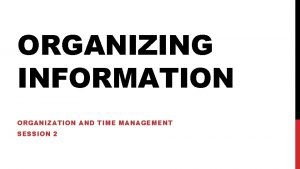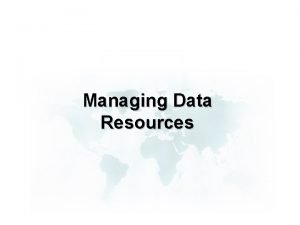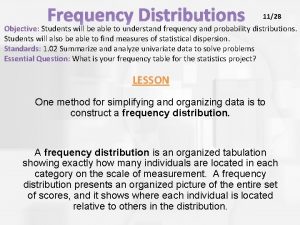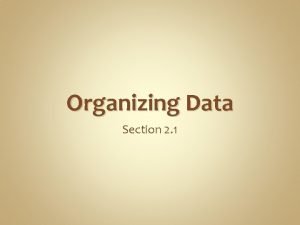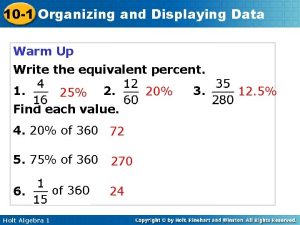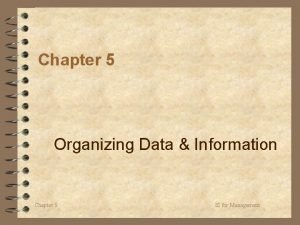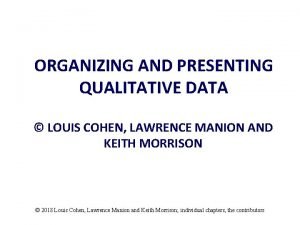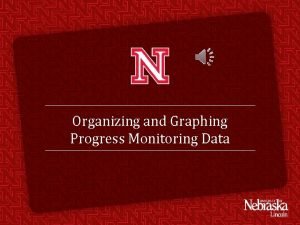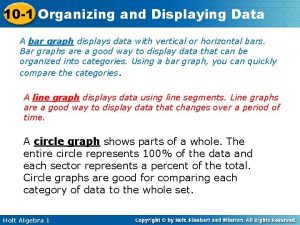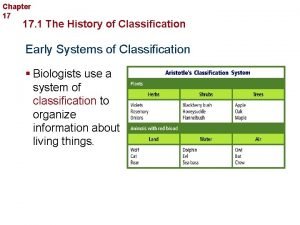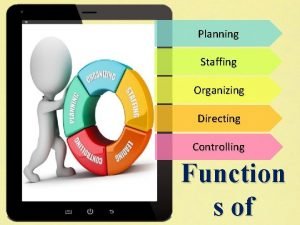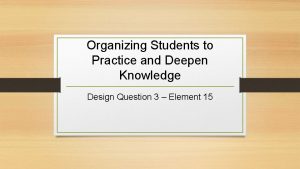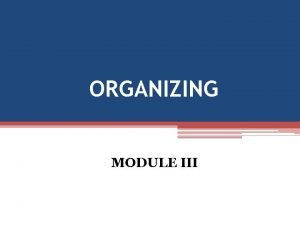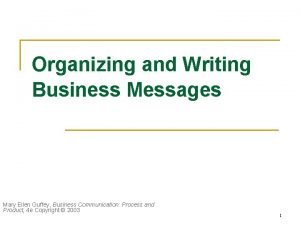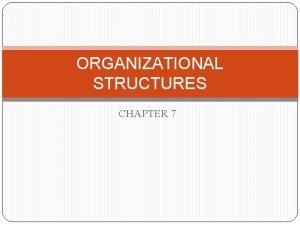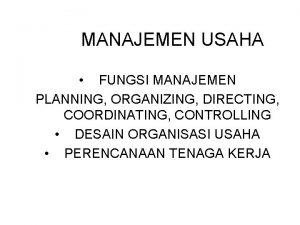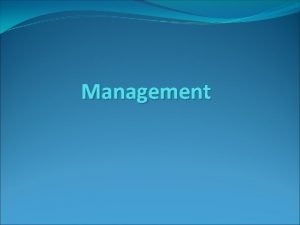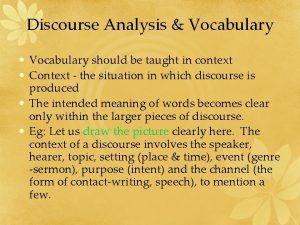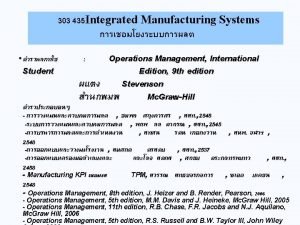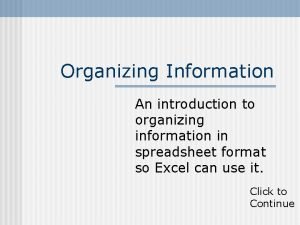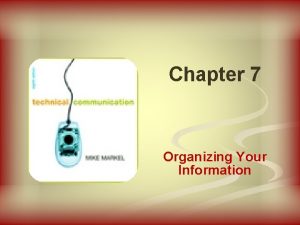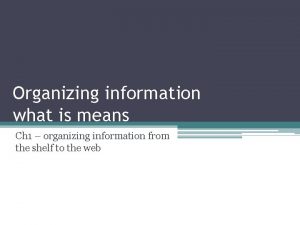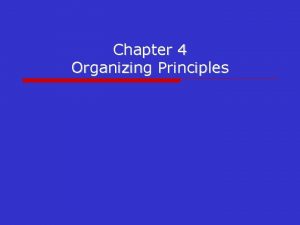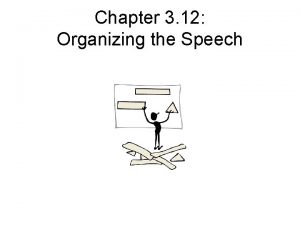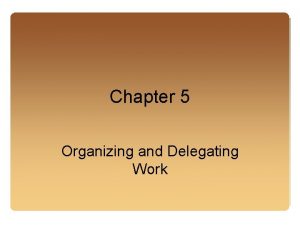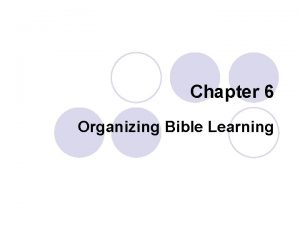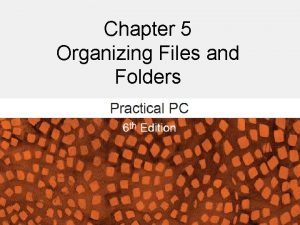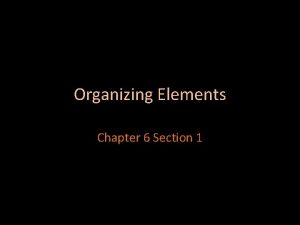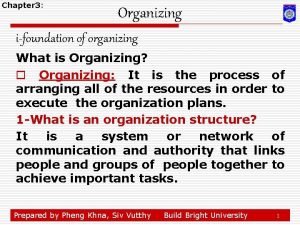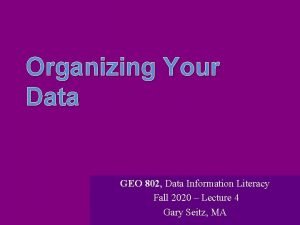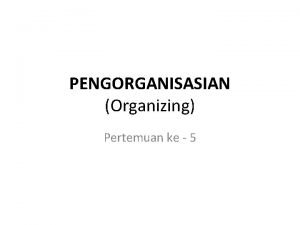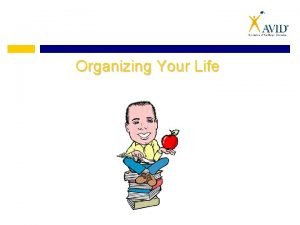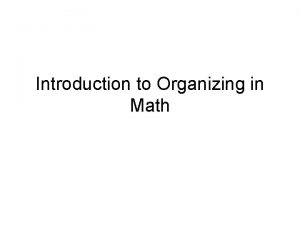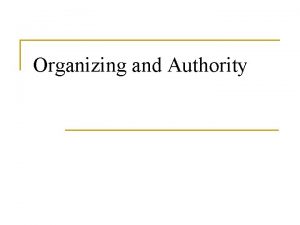Chapter 5 Organizing Data Information Chapter 5 IS

























- Slides: 25

Chapter 5 Organizing Data & Information Chapter 5 IS for Management

Data & Databases Data consists of raw facts that when organized may be transformed into information A Database is a collection of data organized to meet users’ needs A Database Management System (DBMS) is a group of programs that manipulate the database & provide an interface between the database & the user of the database or other application programs Chapter 5 2 IS for Management

The Hierarchy of Data (Figure 5. 1) Database Management System Database File (table) Record (entity, row) Field (characteristic, column) Chapter 5 Byte 3 (character) IS for Management

Data Entities, Attributes, & Keys 4 Entity: A generalized class of people, places, or things for which data is collected, stored, & maintained • Examples: customers, employees 4 Attribute: A characteristic of an entity; something the entity is identified by • Examples: customer name, employee name 4 Key: A field or set of fields in a record that is a unique identifier of a record • Examples: social insurance number, customer number Chapter 5 4 IS for Management

Keys & Attributes (Figure 5. 2) <-------------------Attributes------------------> Last Name First Name Hire Date Department Number 005 -10 -6321 Johns Francine 10 -7 -65 257 549 -77 -1001 Buckley Bill 2 -17 -79 650 098 -40 -1370 Fiske Steven 1 -5 -85 598 <----Entities----> (records) Employee Number Key Field Chapter 5 5 IS for Management

The Traditional Approach (Figure 5. 3) Separate files are created & stored for each application program Chapter 5 6 IS for Management

Drawbacks to the Traditional Approach 4 Data redundancy – Duplication of data in separate files 4 Lack of data integrity – The degree to which the data in any one file is accurate 4 Program-data dependence – A situation in which programs & data organized for one application are incompatible with programs & data organized differently for another application 4 Inability to Link Data Chapter 5 7 IS for Management

The Database Approach (Figure 5. 4) A pool of related data is shared by multiple applications. Rather than having separate data files, each application uses a collection of data that is either joined or related in the database. Chapter 5 8 IS for Management

Advantages to the Database Approach 4 Improved strategic use of corporate data 4 Reduced data redundancy 4 Improved data integrity 4 Easier modification & updating 4 Data & program independence 4 Better access to data & information 4 Standardization of data access 4 A framework for program development 4 Better overall protection of the data 4 Shared data & information resources Chapter 5 9 IS for Management

Disadvantages to the Database Approach 4 Relatively high cost of purchasing & operating a DBMS in a mainframe operating environment 4 Increased cost of specialized staff 4 Increased vulnerability Chapter 5 10 IS for Management

Database Design 4 Logical design precedes physical design – Abstract model of how data should be structured & arranged – Users should assist in creating logical design 4 Physical design starts with the logical design – What specific hardware/software will be used – Fine-tuning of logical design for performance/cost considerations – Planned Data Redundancy • A way of organizing data in which the logical database design is altered so that certain data entities are combined – Summary totals are carried in the data records rather than calculated from elemental data – Some data attributes are repeated in more than one data entity to improve database performance Chapter 5 11 IS for Management

Data Modeling 4 Data Model – A map or diagram of entities & their relationships 4 Enterprise data modeling – Data modeling done at the level of the entire organization 4 Entity-Relationship (ER) diagrams – A data model that uses basic graphical symbols to show the organization of & relationships between data (Figure 5. 5) Chapter 5 12 IS for Management

Database Models 4 Hierarchical (Figure 5. 6): A data model in which the data is organized in a top-down or inverted tree structure 4 Network (Figure 5. 7): An expansion of the hierarchical database model with an owner-member relationship in which a member may have many owners 4 Relational (Figure 5. 8): All data elements are placed in two-dimensional tables, called relations, that are the logical equivalent of files Chapter 5 13 IS for Management

A Relational Database (3 tables) Chapter 5 14 IS for Management

Relational Database Terminology 4 Domain: Allowable values for attributes 4 Selecting: Data manipulation that eliminates rows (records) according to user-defined criteria 4 Projecting: Data manipulation that eliminates columns (attributes) in a table 4 Joining: Data manipulation that combines two or more tables 4 Linking: Relating tables in a relational database together by a common attribute(s) Chapter 5 15 IS for Management

Schemas & Subschemas 4 Schema – View of the entire database – Includes logical & physical structure & relationships among all data 4 Subschema – User view of a portion of the database – Can have many subschemas for one database Chapter 5 16 IS for Management

Data Definition Language & Dictionary 4 Data Definition Language (DDL) – A collection of instructions & commands used to define & describe data & data relationships in a database 4 Data Dictionary – A detailed description of all data used in the database • • Chapter 5 Provides a standard definition of terms & data elements Assists programmers in designing & writing programs Simplifies database modification Reduces data redundancy Increases data reliability Faster program development Easier modification of data & information 17 IS for Management

Logical & Physical Access Paths (Figure 5. 14) Physical Access Path DBMS accesses a storage device to retrieve data Data on Storage Device DBMS Logical Access Path Application requires information from the DBMS Chapter 5 Management inquiries 18 Other Software Application Programs IS for Management

Manipulating Data 4 Concurrency Control – A method of dealing with a situation in which two or more people need to access the same record in a database at the same time 4 Data Manipulation Language (DML) – The commands that are used to manipulate the data in a database 4 Structured Query Language (SQL) – A standardized data manipulation language for querying a database – Most modern databases are SQL compliant Chapter 5 19 IS for Management

DBMS Selection Criteria 4 Database size 4 Number of concurrent users 4 Performance 4 Integration 4 Features 4 Vendor 4 Cost Chapter 5 20 IS for Management

Database Developments (1) 4 Distributed Database – A database in which the actual data may be spread across several smaller databases connected via telecommunications devices – Transparent to user (user does not know where data is) 4 Replicated Database – Duplicate of original database (saves telecom time/$$) Chapter 5 21 IS for Management

Database Developments (2) 4 Data Warehouse – A relational database management system designed specifically to support management decision making 4 Data Mart – A subset of a data warehouse for small & medium-size businesses or departments within larger companies 4 Data Mining – Automated discovery of patterns & relationships in a data warehouse – Built-in analysis tools Chapter 5 22 IS for Management

Database Developments (3) 4 On-line Transaction Processing (OLTP) – TP happens at time of transaction 4 On-line Analytical Processing (OLAP) – Supports high speed analysis of data involving complex relationships 4 Multidimensional Databases – Data can include graphics, photographs, sound files, etc. 4 Open Database Connectivity (ODBC) – Software written in compliance with ODBC standards can be used with any ODBC-compliant database Chapter 5 23 IS for Management

Object-Relational Database Management Systems Can manipulate audio, video, & graphical data 4 Hypertext: Users can search & manipulate alphanumeric data in an unstructured way 4 Hypermedia: Users can search & manipulate multimedia forms of data 4 Spatial Data Technology: Use of an objectrelational database to store & access data according to the location it describes & to permit spatial queries & analysis Chapter 5 24 IS for Management

Case 4 US West Chapter 5 25 IS for Management
 Selecting organizing and interpreting information
Selecting organizing and interpreting information Organizing information examples
Organizing information examples Organizing data in a traditional file environment
Organizing data in a traditional file environment Organizing data using frequency distribution
Organizing data using frequency distribution Organizing qualitative data
Organizing qualitative data Organizing and displaying data
Organizing and displaying data Organizing data definition
Organizing data definition Analytic tools
Analytic tools Organizing qualitative data
Organizing qualitative data Organizing and graphing data
Organizing and graphing data Organizing and displaying data
Organizing and displaying data Chapter 2 worksheet organizing and administering
Chapter 2 worksheet organizing and administering Chapter 17 organizing life's diversity
Chapter 17 organizing life's diversity Introduction for portfolio
Introduction for portfolio Planning and staffing
Planning and staffing Organizing committee structure for an event
Organizing committee structure for an event Structure follows strategy
Structure follows strategy Planning directing controlling organizing
Planning directing controlling organizing Marzano element 15
Marzano element 15 Work specialization
Work specialization Direct paragraph
Direct paragraph Organizing an outline
Organizing an outline Organizing in management
Organizing in management Directing controlling
Directing controlling Manager is someone who
Manager is someone who Register and signaling vocabulary
Register and signaling vocabulary

